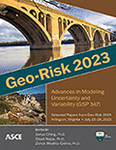Characterization of Geotechnical Model Uncertainties Using a Non-Invasive Geophysical Approach
Publication: Geo-Risk 2023
ABSTRACT
Geo-risk assessment depends on a though and accurate characterization of geotechnical model. However, subsurface lithological variations and inadequate well data produce uncertainties in such models, which often lead to large societal hazards such as collapse of engineered structures, geohazards, etc. Accurate valuation of geotechnical model mainly depends on rock mass quality assessment. Geotechnical parameters such as Young’s modulus are used in the assessments of rock mass strength. However, engineering parameters are conventionally obtained via drilling tests. Borehole methods are pricey, time-taking; require more equipment; provide point-scale data; offer vertical data coverage only at shallow depths; and are barely conducted in the steep topographic terrains. Alternatively, geophysical methods provide rapid, less invasive, more economical, less time-consuming, and more user-friendly way for geotechnical investigation. In this paper, we propose suitable and direct link between geotechnical and geophysical parameters. The proposed approach is more meaningful and reliable to obtain geotechnical parameters using geophysical data of CSAMT method. Our approach provides adaptable formulas to obtain engineering parameters where even though no well data is accessible. Our methodology provides more accurate geotechnical models for thorough geo-risk evaluation at large depths. This research reduces the uncertainty due to structural heterogeneities and inadequate drilling tests, narrows the gap between insufficient geological knowledge and a true geotechnical model, and offers a comprehensive insight into rock mass strength assessment.
Get full access to this article
View all available purchase options and get full access to this chapter.
REFERENCES
Armaghani, D. J., Mohamad, E. T., Momeni, E., and Narayanasamy, M. S. (2015). “An adaptive neuro-fuzzy inference system for predicting unconfined compressive strength and Young’s modulus: a study on Main Range granite”. Bull Eng Geol Environ, 74, 1301–1319.
Gokceoglu, C., and Zorlu, K. (2004). “A fuzzy model to predict the uniaxial compressive strength and the modulus of elasticity of a problematic rock”. Eng Appl Artif Intell, 17, 61–72.
Hoek, E., and Brown, E. T. (1997). “Practical estimates of rock mass strength”. Int J Rock Mech Min Sci, 34,1165–1186.
Ji, F., Shi, Y., Li, R., Zhou, C., Zhang, N., and Gao, J. (2019). “Modified Q-index for prediction of rock mass quality around a tunnel excavated with a tunnel boring machine (TBM)”. Bulletin of Engineering Geology and the Environment, 78, 3755–3766.
Nourani, M. H., Moghadder, M. T., and Safari, M. (2017). “Classification and Assessment of Rock Mass Parameters in Choghart Iron Mine Using P-wave Velocity”. Journal of Rock Mechanics and Geotechnical Engineering, 9, 318–328.
Olayanju, G. M., Mogaji, K. A., Lim, H. S., and Ojo, T. S. (2017). “Foundation integrity assessment using integrated geophysical and geotechnical techniques: case study in crystalline basement complex, southwestern Nigeria”. Jour. Geophy. Eng, 14 (3).
Rehman, H., Naji, A. M., Kim, J. J., and Yoo, H. K. (2018). “Empirical evaluation of rock mass rating and tunneling quality index system for tunnel support design”. Appl Sci, 8,782.
Salaamah, A. F., Fathani, T. F., and Wilopo, W. (2018). “Correlation of P-wave Velocity with Rock Quality Designation (RQD) in Volcanic Rocks”. Journal of Applied Geology, 3(2), 62–72.
Sharma, P. K., and Singh, T. N. (2008). “A correlation between P-wave velocity, impact strength index, slake durability index and uniaxial compressive strength”. Bulletin of Engineering Geology and the Environment, 67(1), 17–22.
Singh, M., and Rao, K. S. (2005). “Empirical methods to estimate the strength of jointed rock masses”. Eng. Geol, 77,127–137.
Tiryaki, B. (2008). “Predicting intact rock strength for mechanical excavation using multivariate statistics, artificial neural networks, and regression trees”. Eng Geol, 99, 51–60.
Wang, R., Yin, C., Wang, M., and Di, Q. (2015). “Laterally constrained inversion for CSAMT data interpretation”. Journal of Applied Geophysics, 121, 63–70.
Zhang, M., Farquharson, C. G., and Li, C. (2021). “Improved controlled source audio-frequency magnetotelluric method apparent resistivity pseudo-sections based on the frequency and frequency–spatial gradients of electromagnetic fields”. Geophysical Prospecting, 69, 474–490.
Information & Authors
Information
Published In
History
Published online: Jul 20, 2023
ASCE Technical Topics:
- Continuum mechanics
- Dynamics (solid mechanics)
- Engineering fundamentals
- Engineering mechanics
- Geohazards
- Geomechanics
- Geotechnical engineering
- Geotechnical models
- Mathematics
- Model accuracy
- Models (by type)
- Motion (dynamics)
- Parameters (statistics)
- Rock masses
- Rock mechanics
- Solid mechanics
- Statistics
- Structural models
- Uncertainty principles
Authors
Metrics & Citations
Metrics
Citations
Download citation
If you have the appropriate software installed, you can download article citation data to the citation manager of your choice. Simply select your manager software from the list below and click Download.
